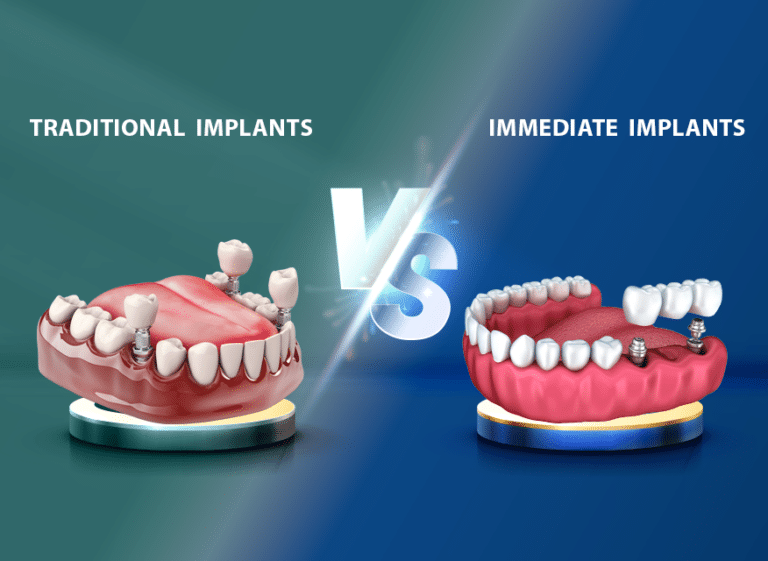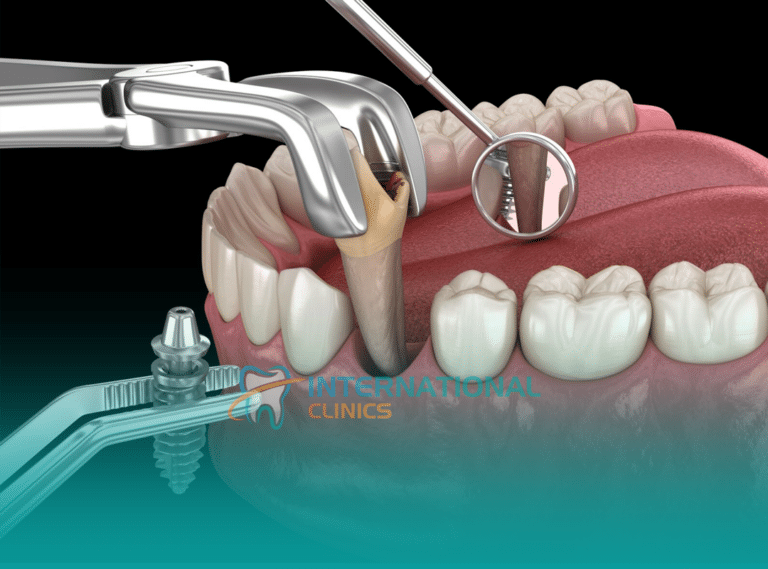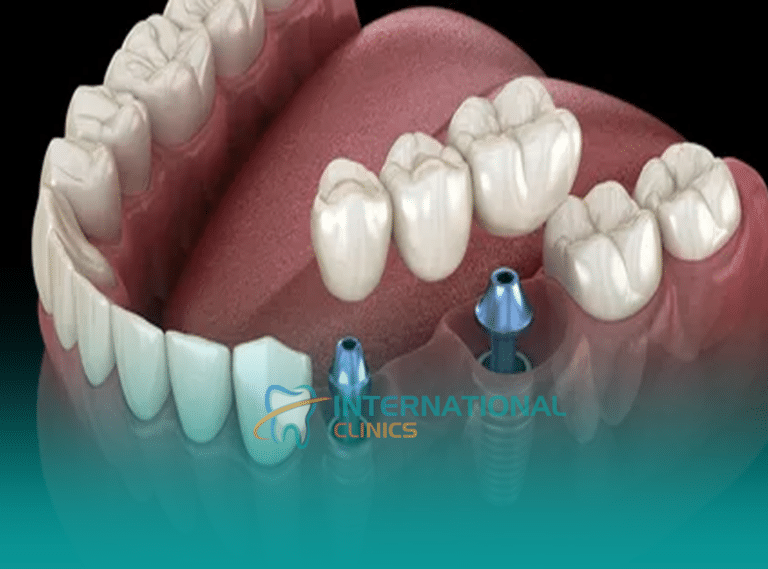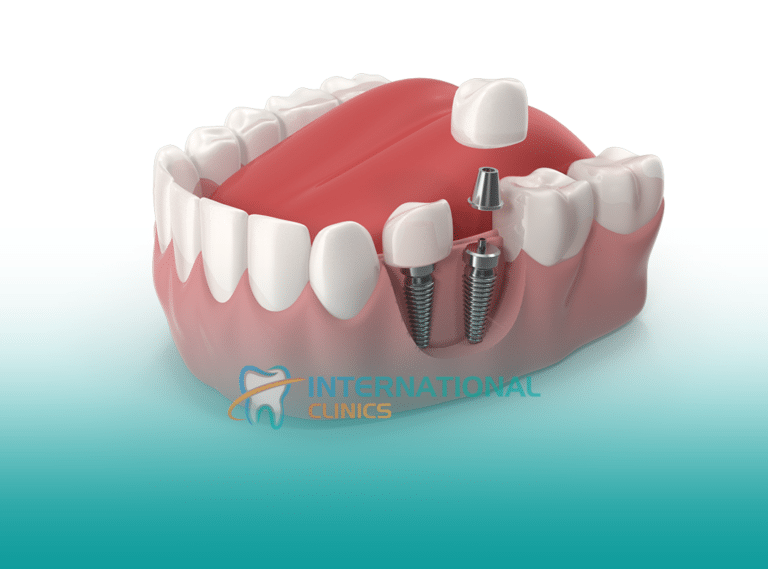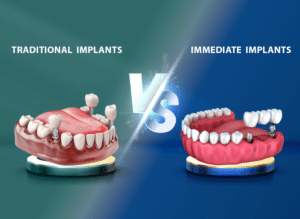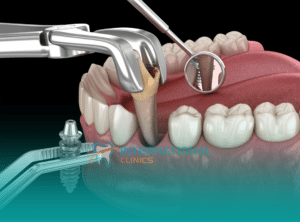Tooth loss impairs both function and aesthetics! It’s a clear loss, but there is no reason to think it can’t be fixed immediately!
Whether the tooth loss was due to disease, injury, or natural aging, modern dentistry offers excellent solutions for replacing missing teeth.
Dental implants in Turkey have surged in popularity among people of all ages over the past few decades.
While traditional implant treatment requires months between tooth extraction and the final prosthetic restoration, the new immediate dental implants do the job in a very short time.
For many patients, the prolonged duration of dental treatments is deeply undesirable. Immediate implant placement helps accelerate the whole treatment process.
After tooth extraction, an implant is inserted into the socket for immediate replacement. In other words, this new approach delivers a prosthetic tooth soon after extraction.
For the right patients, immediate implants can provide faster, more comfortable restoration of dental function and a beautiful smile.
What Is Immediate Teeth Implantation?
Immediate implant placement involves inserting a dental implant into a newly extracted tooth socket, right after tooth removal and in a record time.
This contrasts with traditional or delayed placement, which requires healing of the socket over 3-6 months before implant insertion.
With immediate placement, an implant can be fitted at the time of (or immediately after) extraction to replace the missing tooth root.
After numbing the area, the dentist will gently extract the tooth while taking care to preserve the surrounding bone and gum tissues.
The socket is then prepared, and an implant is screwed into optimal position within the bone walls. Sutures are placed to stabilize the tissues around the implant as healing begins.
Surely, an abutment and temporary crown can sometimes be attached immediately to provide an instant replacement tooth. After several weeks of healing, the site will be re-evaluated.
At this point, the dentist will replace the temporary restoration with a custom-made permanent crown fitted over the abutment.
The final crown effectively replaces the extracted tooth with a functional and natural-looking prosthesis.
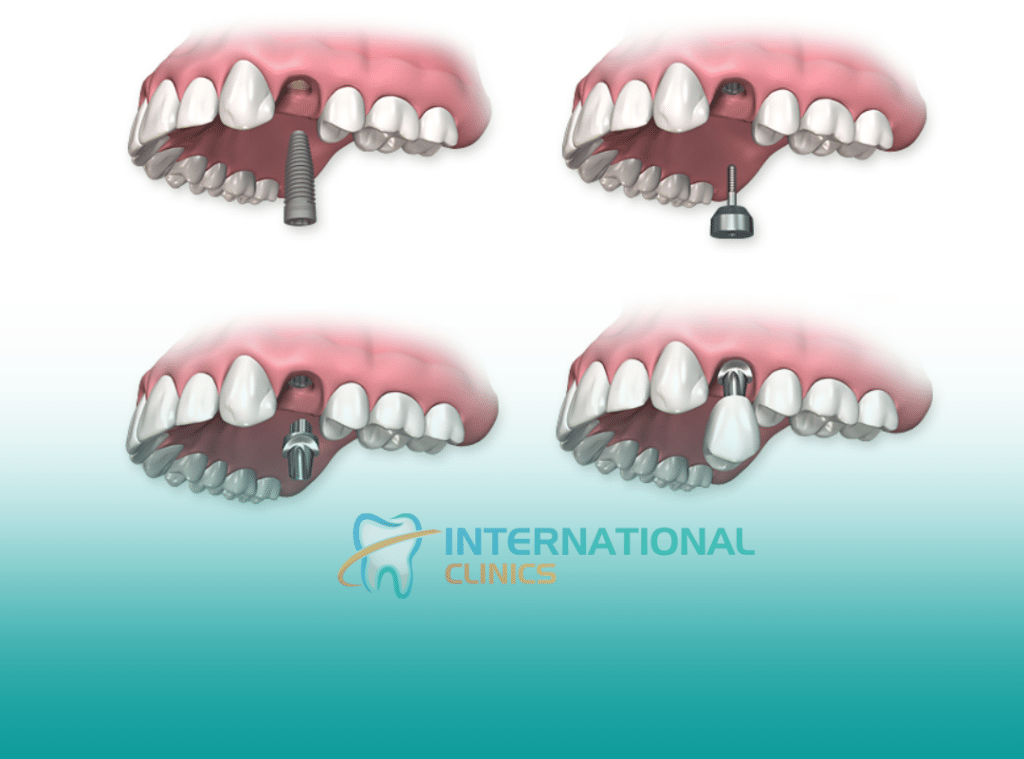
Why Immediate Teeth Implantation?
Immediate implant placement comes with several advantages that challenge the benefits of traditional placement. Such advantages include:
Shorter Treatment Time
With immediate placement, implant restoration can be completed in as little as 8-12 weeks. Delayed placement, on the other hand, requires at least 3-6 months of socket healing before the implant process can even begin.
Less Invasive Procedure
Immediate placement utilizes the fresh extraction socket, eliminating the need for additional bone drilling after healing. This results in less trauma to the bone and overlying soft tissues.
Preserves Bone Integrity
The implant root inserted into the fresh socket helps maintain the bone volume and prevent resorption that naturally occurs after extractions. This can improve long-term stability and support.
Satisfactory Aesthetic Results
Placing an implant immediately means surrounding tissues are quickly preserved. This provides better support for the final restoration, allowing optimal aesthetics to be achieved.
Reduced Treatment Costs
Though immediate implants cost more per visit, the condensed treatment timeline ultimately requires fewer visits/procedures than delayed placement. This significantly reduces overall expenses.
Improved Function
Patients receive a temporary restoration shortly after extraction and the final prosthesis as soon as 8-12 weeks. This rapid tooth replacement minimizes the duration of impaired chewing and speech.
Procedure of Immediate Teeth Implantation
The process of immediate implant placement involves different steps that may include:
- Consultation: The dentist will assess the extraction site for bone quantity/quality.
- Extraction of tooth: The tooth will be gently removed while protecting the surrounding bone and soft tissues as much as possible.
- Implant site preparation: The fresh socket will be debrided and expanded using drills to form an osteotomy (cavity) suited for the implant dimensions.
- Implant placement: The implant will be inserted into the prepared osteotomy, often with primary stability from the bone walls.
- Restoration with healing abutment: A transmucosal abutment is attached to project through the gums during healing. This protects the site and shapes the soft tissue contour.
- Suturing gums: The gums are sutured around the abutment and over the extraction socket to stabilize and protect the site as it starts healing.
- Placement of temporary crown: In some cases, a temporary crown might be placed on the abutment immediately after suturing to provide a prosthetic replacement.
- Healing period: The patient will return after 4-6 weeks to assess healing and integrate the implant with the bone (osseointegration).
- Impressions for permanent crown: An impression will be taken to design and fabricate a permanent crown contoured for optimal fit and aesthetics.
- Placement of final restoration: Around 8-12 weeks after implant placement, the temporary crown is replaced with a custom-made permanent crown secured over the integrated implant.
Risks of Immediate Teeth Implantation
Providing immediate teeth implantation requires experience and surgical precision from the dentist’s side. Regardless of the benefits associated with immediate implantation, there are many potential risks:
- Infection: Bacteria can enter the surgical site and cause infection. Strict oral hygiene and antibiotics, of course, can reduce this risk.
- Implant failure: The implant may fail to osseointegrate properly with the surrounding bone, requiring removal.
- Aesthetic issues: If the soft tissue recedes over time, the implant crown edge may become visible, which requires a new crown or other procedures.
- Damage to adjacent teeth: Though rare, immediate implantation can inadvertently impact neighboring teeth during drilling or implant placement.
- Nerve injury: In lower molars, the nerve that runs through the jaw may suffer trauma, resulting in numbness of the lip, chin, or tongue.
- Bone loss: If implants are overloaded, microfractures and loss of supporting bone can occur.
- Need for bone grafting: If the extraction socket lacks adequate bone, grafting may be needed when the implant is placed. This adds cost and time to treatment.
Recovery After Immediate Teeth Implantation
The recovery process after immediate teeth implantation is very crucial for the success of the procedure. Patients are recommended to follow the next tips during the recovery period:
- Refrain from strenuous exercise and exertion to allow the initial healing stages to begin. Use an ice pack on the face to reduce swelling.
- Antibiotics, anti-inflammatories, and pain relievers will help manage post-surgical discomfort and prevent infection as healing progresses.
- For at least 1-2 weeks, consume a soft food diet to avoid disturbing the implant and extraction site during chewing.
- Brush other teeth normally but avoid the implant area for a week or so. Use antiseptic mouthwash to keep the mouth clean.
- Refrain from smoking, excessive alcohol, or sucking motions for 2 months post-op as these can disrupt proper osseointegration.
- Your dentist will monitor healing and make certain adjustments. Temporary prosthetics may need replacement during recovery.
- Report any worrisome symptoms like excessive pain, swelling or bleeding to your implant dentist promptly.
Cost of Immediate Teeth Implantation
The cost of immediate implantation is generally higher than delayed placement, but the overall expenses are often lower as you will have fewer visits and procedures. The cost per implant can range from:
- 600 – 1500 US dollars for the immediate implant placement procedure
- 200 – 500 US dollars for the final crown fabrication and placement
- 500 – 1000 US dollars for alternative procedures like bone grafting or sinus lift, if needed
Dental insurance may cover a portion of the treatment fees, at least in some cases. Overall, immediate implantation provides functional and aesthetic tooth replacement in the shortest time possible, despite higher upfront costs.
Immediate Teeth Implantation in Turkey

Dental or medical tourism in Turkey is growing, thanks to the country’s good reputation and low costs.
For those seeking excellent dental implants at affordable prices in a trusted and safe location, Turkey might be the right destination.
People who choose to have immediate teeth implantation in Turkey enjoy benefits such as:
- Significantly lower treatment fees: Implant procedures in Turkey usually cost less than in other countries by a large margin.
- Highly skilled dental surgeons: Turkish dentists are popular in Europe, North America, and the Middle East.
- Respected Clinics: Many clinics, such as International Clinics, rival the technology and capabilities found in Western counterparts.
- Opportunity to combine with a vacation: Turkey is a “flagship” in the domain of tourism and leisure traveling.
- Fast, high-quality care: Reputable Turkish clinics emphasize delivering efficient, reliable implant treatment to international patients.
- No waiting periods: Appointments happen quickly, without long waits compared to public healthcare abroad.
The Bottom Line
Immediate implantation is a faster and potentially superior alternative to conventional or delayed placement.
The approach shortens recovery time while also better preserving the surrounding bone and soft tissues as the dentist quickly inserts an implant into the fresh socket after extraction.
Ideal candidates can enjoy a new implant-supported crown in as little as 8-12 weeks. Although immediate implantation costs more and has higher surgical risks, many patients feel the benefits outweigh the downsides.
Turkey is one of the reputable destinations for affordable immediate tooth implantation.
International Clinics in Istanbul is known for its innovative immediate teeth implantation. We continue to expand and improve possibilities for functional, confident smiles. Contact us right now to explore your treatment options.
Frequently Asked Questions
Proper patient selection and technique guarantee the success rates for immediate implantation to be similar to traditional implants.
With proper maintenance and oral hygiene, an immediate implanted tooth can last decades, just like natural teeth. However, similar to natural teeth, implants may need periodic repair or replacement of components like the abutment or crown over time.
The extraction and implant surgery involves mild to moderate discomfort. However, numbness from local anesthesia keeps most pain sensations at bay during the procedure.
Unfortunately, immediate implantation isn’t feasible with every extraction socket. The dentist must ensure adequate bone quantity and quality exists to stabilize the implant. Extensive decay or trauma may preclude immediate placement.
During the first 24 hours, a soft foods diet is recommended. Foods like yogurt, applesauce, soups, pasta, and scrambled eggs are ideal. After the first day, patients should still avoid very hard, crunchy, spicy, or hot foods that could irritate the implant and extraction site.
Generally, after 6-8 weeks of initial healing, the site will be ready for impressions and fabrication of the permanent crown. The temporary crown protects the site in the interim. Around 8-12 weeks post-op, the permanent crown can be seated safely over the integrated implant.
Alternatives include no replacement, a removable partial denture, or a fixed dental bridge. However, immediate implants often provide the most functional, comfortable, and aesthetic replacement option for missing teeth. Traditional delayed implant placement is also an option but requires more time and surgical procedures.

